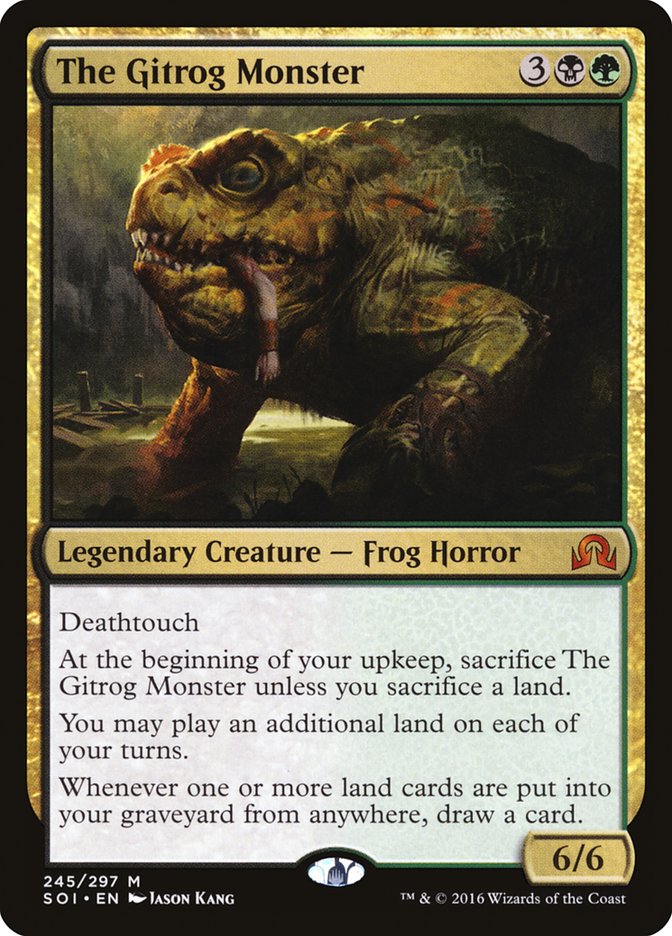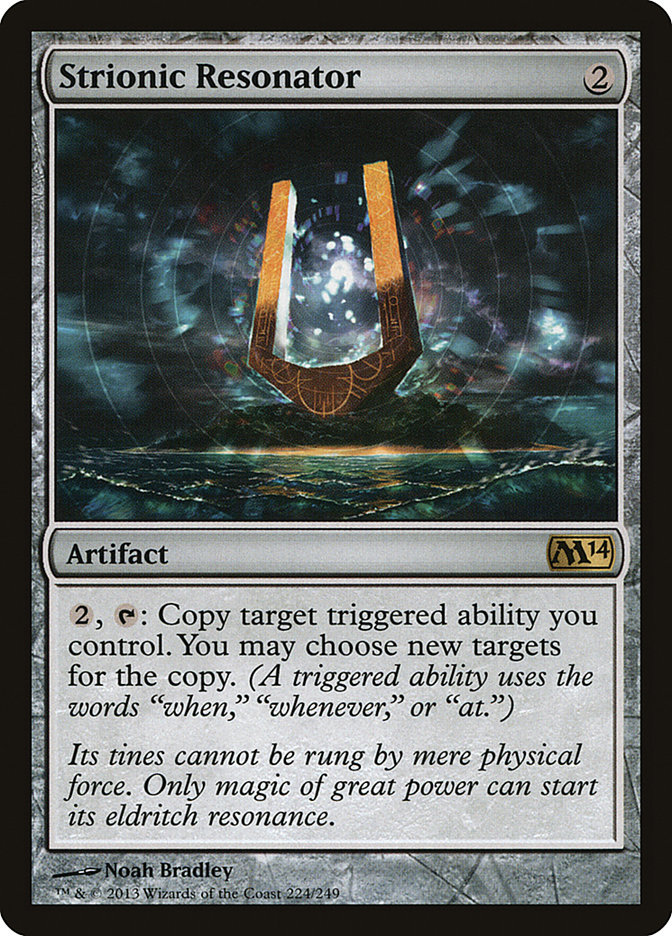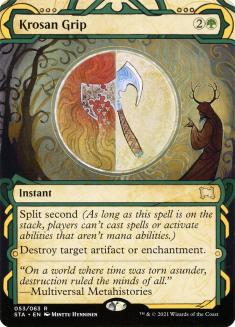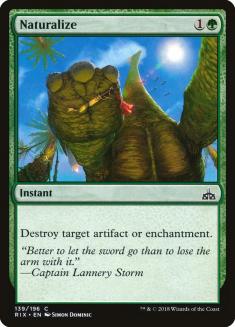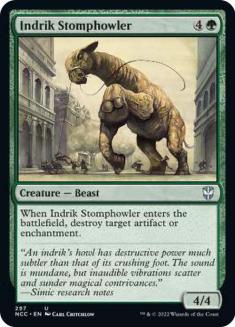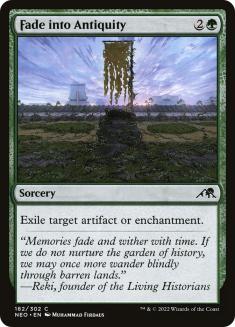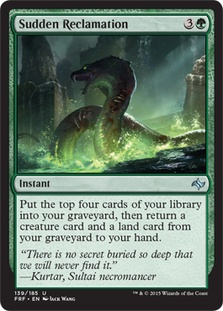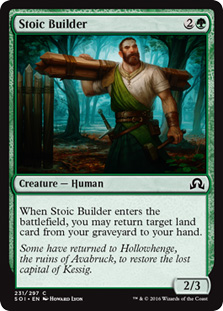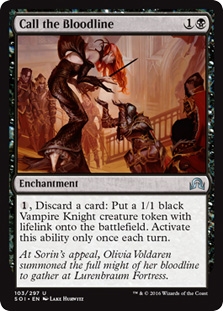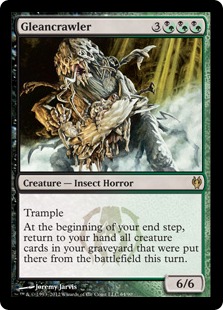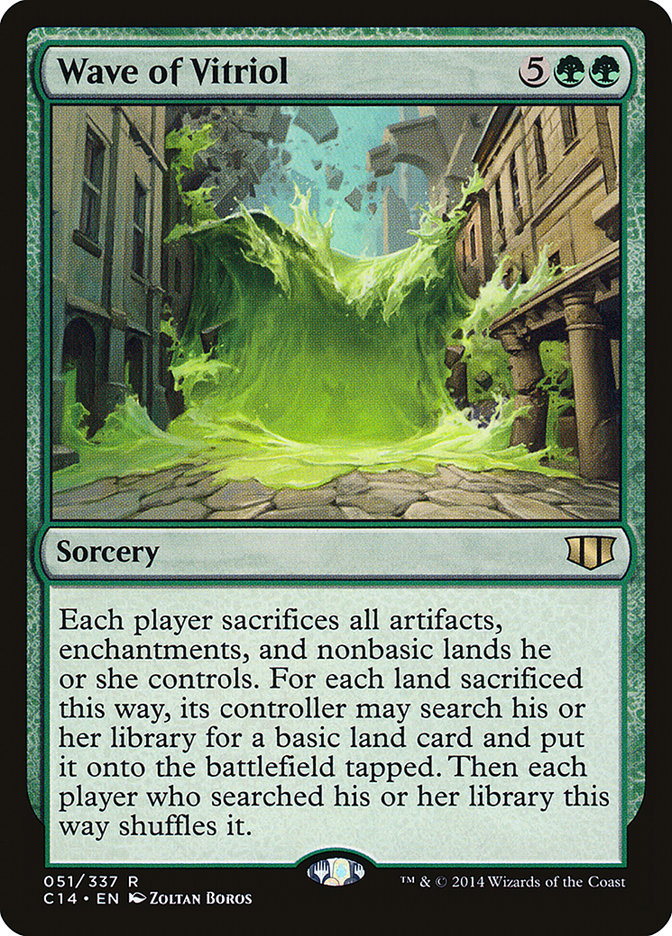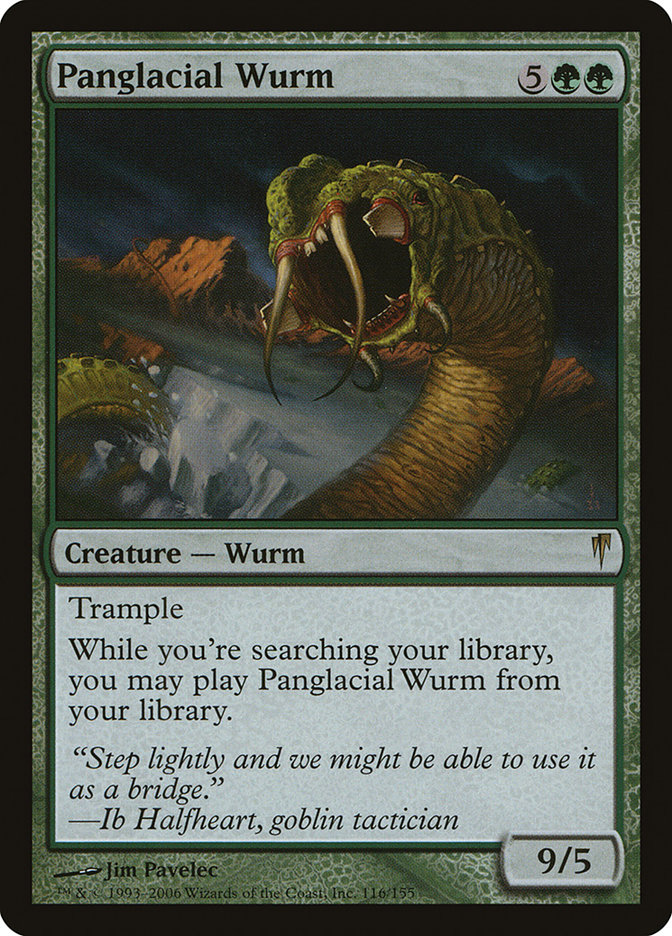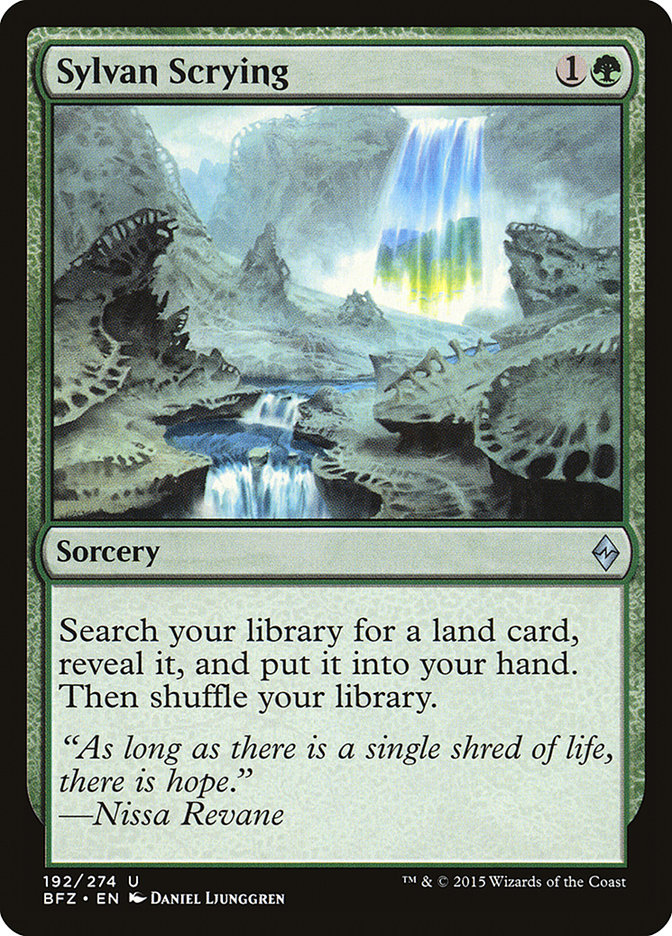If Commander is a brewer’s paradise, I’m not quite sure what to call the land of tuning and tweaking. Perhaps it is just over the hill in paradise and all a part of the same joy. Even if I don’t have the same snappy title for it, tweaking and tuning a deck is a huge part of Commander. How many players look forward to every expansion for shiny new cards to tweak their deck? Or to the upcoming Eternal Masters to get their hands on hard-to-find cards or sweet foily goodness of old classics that were unavailable before?
Loads of us. We love the ability to find new cards to add. Finding new cards is as easy as breathing or searching a card database for a specific line of rules text. Finding the room in your deck is a hurdle. Finding room in a Commander deck that does well and has a strong theme… that is an undertaking. But have no fear! I’ll explain how I make cuts in a deck using examples from my The Gitrog Monster Commander deck.
Why We Tune
Tuning a deck is like tuning an instrument (I’m pretty sure we’re borrowing musical terminology on this one). My tuning experience is with a saxophone, so I’m going to continue. You play a note, Concert Bb (B flat) in my experience, and have a tuner that indicates if you are sharp or flat. From here you make adjustments on the mouthpiece, pushing it in a little further if flat and pulling the mouthpiece out a little further if sharp. The end result after repeating this is that your played Concert Bb is in tune. From here you work to make sure your other notes are in tune, and that you are in tune with yourself (basically, when a note changes a whole note, you actually change a whole note, so moving from C to B doesn’t result in C to Bb) so that all of your notes are played correctly.
Tuning a deck follows a similar pattern of comparing to the ideal. Commander has a moving target for the ideal; this shifts mainly due to group and deck goals. But we still follow the same procedure of comparing to the ideal and making changes. While there may not be an ideal deck, many players pursue the deck that runs optimally for their expectations. Tuning in most Constructed formats is often about moving pieces between the maindeck and sideboard or finding a card not previously used in the deck to win a given tournament. Commander is a little different because of the casual nature for the game. Winning is not the sole requirement for the game.
What We Tune
Tuning to the ideal for Commander is more about tuning for a goal than the ideal tournament deck. The goals for commander fall in a few categories: focus, answers, and the metagame.
Tuning around a focus happens in a few common ways. One is focusing the theme of the deck. This can be as simple as adding cards that push a deck’s focus, like adding Nahiri, the Harbinger in Gisela, Angel of Goldnight to up the control abilities and get some needed card drawing. Sometimes it’s cutting cards that are good-stuff inclusions or just finding more support cards for a theme, like discovering Juniper Order Ranger is a card. Focusing can also tweak a deck for mechanics, most often building around a mechanical theme or adding mechanics that the deck lacks (evasion most often).
One aspect of tweaking that is very often overlooked is the mana. You cannot win if you cannot cast your spells! Run enough lands, and when you overhaul a deck, make sure that you go over your mana to ensure you have the right distribution of colors. Here is an old, but excellent, article that is very easy to use in Commander. Thanks to Dr. Mouldenhauer-Salazar, I constantly use this advice when helping players.
The last part of focusing is focusing on speed. Many Commander decks want to speed up their gameplay. Six- and seven-drops are fun, but casting them on turn 4 or 5 is a blast. Tweaking a deck for speed is the last of the most common tweaks I often see for focusing a deck.
Tuning frequently takes another form, adding answers to your opponents. The most basic lesson here is run answers already! The number of decks that cannot interact with a table outside combat is astounding. Lurking Predators is a card that can dominate a table; you should have a response to it. There are lots of cards that practically demand an answer. Spot removal (for creatures and non-creature permanents) and sweepers make sure you keep your opponents in check.
Racing is not the only answer. Resiliency helps too. Resiliency through recursion lets you get back into the game. Redundancy is another form of resilience for your deck; Krosan Grip is excellent, but running Naturalize, Indrik Stomphowler, Acidic Slime, and Fade into Antiquity ensures that your deck can deal with multiple artifacts or enchantments. A resilient deck competes against the table; a resilient and focused deck thrives.
Finally, I want to touch on metagaming. This is different from metagaming in tournaments. Instead, we are looking for ways to exploit the trends that our friends follow. For example, The Gitrog Monster deck I’ve been playing is still succeeding wonderfully with Worm Harvest. This is mostly due to a near-complete lack of graveyard hate. I do expect my friends to start running more soon, but until they do, I do not need to change that aspect of the deck.
However, my girlfriend wrecked me in a game with Sire of Stagnation. Its effect made it so that basically every time I had a land enter the battlefield, the Sire stripped most of the answers I had to it. This relates to running answers; sometimes the obvious ones aren’t the only answers. Sire of Stagnation is one example. The Gitrog Monster hits multiple land drops a turn to develop mana, but the Sire hurt the Frog while punishing anyone else who blindly plays lands.
My Deckbuilding Philosophy
I want a deck to have a goal to accomplish in the game, to have a thing. During the game, I am trying to win, but I am also trying to accomplish a specific goal. Most often this is a mechanical thing, such as Gisela, Blade of Goldnight trying to put a huge clock on the game or Jori En, Ruin Diver trying to trigger her draw effect as often as possible. Other times, the deck is built to show off something, like art-themed decks or a tribal deck. And sometimes, the deck’s focus is something silly like Ramirez DePietro being awesome, getting a ship, pirates, stolen booty (artifacts from opponents most often), a cannon, and Ramirez at the helm. This deck’s goal is to get a flavor win, then remember to take a picture and post it to Twitter, or sometimes (once) win.
If I lose a game while I’ve accomplished or been attempting to accomplish my deck’s goal, then I had a good game and enjoy it. Mission accomplished! Commander games are about more than just winning; there is the social aspect and the showing-off category for a deck doing something specific. However, without a specific thing to accomplish, I only want to win. This becomes an issue, because in a four-player game with all things being equal, you only win one out of four games.
When I’m playing without a goal aside from winning, the only thing I enjoy is winning. If I only win a quarter of the time, I am not happy for three quarters of the games! This is also why I dislike tournaments; I’m a hyper-competitive jerk and need something that reins in my need to know what is best in life. Otherwise I’m Captain Grumpypants and no one wants to talk to me. Commander helps keep memore grounded and focused on everyone enjoying the games.
The Gitrog Frog
Back to our friend. Applying this to The Gitrog Monster (too bad The Gitrog Frog rolls off the tongue better) involves cutting some cards that don’t do enough and finding the weak spots in the deck. While I used the Kondo minimalist philosophy as a lens for Culling the Commander Herd, this doesn’t work as well for cutting individual cards from a deck. Instead I prefer to look at cards that are underperforming.
I’m going to get the elephant in the room out of the way first: Scapeshift. The card is awesome for The Gitrog Monster, but it is expensive. The card sees Modern play and is a deck’s namesake. I traded mine away a while ago for a whole boatload of good Commander cards, but I included it in the list because I forgot I traded it. I had to make do without it and I haven’t spent the money for it yet. I don’t think it is necessary, but wow is it good. Sacrificing even two or three lands lets you get Urborg, Tomb of Yawgmoth and Cabal Coffers to power out some huge turns.
Sudden Reclamation is a card that wasted my turn too many times. I seem to always seem to get a bad flip and the four mana isn’t as easily spared as I originally thought. The card doesn’t generate enough value right now.
Herald of Leshrac is sweet but it tends to scare the table a lot. This card has drawn focus fire from the table for having only two lands. This card is also a frequent target for Bribery and then used wonderfully against me to stop my mana development. The situations where this card is turned against me are uphill battles and generally not fun. I can run more consistent cards that won’t be such a help to my opponents.
Stoic Builder is just ineffective. I get back my lands well enough as it is and this card often just rots away in my hand. It’s getting the axe now, but I think the card is awesome. I want to get it back and get Cartographer into the deck as well.
Call the Bloodline is the card getting cut with the most potential. It triggers The Gitrog Monster, gets tokens, helps gain a little bit of life, and is not tied to a creature. However, I have only activated it once in two weeks of playing this deck at least four times a weekend. Once! The cards does nothing right now. The 1/1s build too slowly and are just not worth the mana investment for me. I am going to find a place for this card in a different deck. It’s an awesome card, but this is not the right build for it.
Gleancrawler is the final notable card I cut. This big bug just does so little for me. I run few creatures and Gleancrawler can only return those that die during my turn. Most of the critters what would die in combat are tokens, and tokens poof from existence once they hit the graveyard. For my deck’s goals right now, this card does nothing. In a couple of weeks, I may have this back if I am running more creatures to combat some of the graveyard hate I am expecting.
Here is the deck as of now.
Creatures (21)
- 1 Sakura-Tribe Elder
- 1 Royal Assassin
- 1 Squirrel Wrangler
- 1 Terravore
- 1 Silklash Spider
- 1 Reiver Demon
- 1 Groundskeeper
- 1 Sylvan Safekeeper
- 1 Gurzigost
- 1 Anurid Scavenger
- 1 Vulturous Zombie
- 1 Loaming Shaman
- 1 Tilling Treefolk
- 1 Lord of Extinction
- 1 Ob Nixilis, the Fallen
- 1 Oracle of Mul Daya
- 1 Grave Titan
- 1 Jade Mage
- 1 Courser of Kruphix
- 1 Titania, Protector of Argoth
- 1 Centaur Vinecrasher
Planeswalkers (1)
Lands (45)
- 1 Strip Mine
- 9 Forest
- 1 Cabal Coffers
- 1 Llanowar Wastes
- 8 Swamp
- 1 Scorched Ruins
- 1 Slippery Karst
- 1 Polluted Mire
- 1 Tainted Wood
- 1 Temple of the False God
- 1 Tranquil Thicket
- 1 Barren Moor
- 1 Dust Bowl
- 1 Terminal Moraine
- 1 Overgrown Tomb
- 1 Ghost Quarter
- 1 Terramorphic Expanse
- 1 Urborg, Tomb of Yawgmoth
- 1 Twilight Mire
- 1 Reliquary Tower
- 1 Verdant Catacombs
- 1 Tectonic Edge
- 1 Evolving Wilds
- 1 Command Tower
- 1 Woodland Cemetery
- 1 Jungle Hollow
- 1 Myriad Landscape
- 1 Hissing Quagmire
- 1 Warped Landscape
- 1 Drownyard Temple
Spells (32)
- 1 Genju of the Fens
- 1 Genju of the Cedars
- 1 Exploration
- 1 Sol Ring
- 1 Demonic Tutor
- 1 Diabolic Tutor
- 1 Constant Mists
- 1 Naturalize
- 1 Crucible of Worlds
- 1 Harrow
- 1 Crop Rotation
- 1 Tainted Aether
- 1 Life from the Loam
- 1 Putrefy
- 1 Recollect
- 1 Grim Harvest
- 1 Sudden Spoiling
- 1 Damnation
- 1 Worm Harvest
- 1 Maelstrom Pulse
- 1 Grim Discovery
- 1 Realms Uncharted
- 1 Beast Within
- 1 Diabolic Revelation
- 1 Hero's Downfall
- 1 Restore
- 1 Commander's Sphere
- 1 Wave of Vitriol
- 1 Retreat to Hagra
- 1 Verdant Confluence
- 1 Thought Vessel
- 1 Crawling Sensation

Interesting Changes
Terravore and Ob Nixilis, the Fallen are two beefy creatures that both worth well with the Frog Horror, with Terravore caring about all the dead lands and Ob Nixilis, the Fallen getting a boost from all the land drops. Plus, Ob Nixilis, the Fallen gives the deck another source of attack on an opponent outside combat.
Retreat to Hagra boosts The Gitrog Frog or chips away at the whole table while giving me an itty-bitty life buffer. Recollect is a catchall to get cards back with Crawling Sensation milling me. Crawling Sensation does a ton of work triggering The Gitrog Monster’s drawing effect, helping me draw more cards and giving me 1/1 Insects every time a land goes to my graveyard for the first time a turn.
The last interesting change is Wave of Vitriol. This is usually a card is dislike, as it often harshly punishes three-color decks compared to other decks. However, here it helps deal with problem artifacts and enchantments. When it destroys my non-basic lands, I get to draw a card. I haven’t cast it yet, but I’m looking forward to see what happens when I do.
These cards all fit into the focus areas I talked about above. I focused on the goals of the deck, I added an answer, and I increased the resiliency of the deck with both a non-combat approach and a combat approach to winning. The deck doesn’t need a change in speed at this time, but Retreat and Crawling Sensation both take advantage of my opponents running less enchantment destruction than they should.
Cards Looking for a Home
I have a few cards that I want to find a home in this deck. Pangalcial Wurm looks really fun and this deck searches a lot. Getting out a nine-powered trampler would benefit the deck’s offense. Plus, I could effectively flash this in if I search during someone else’s turn. Sylvan Scrying is just a handy way to find lands that I need with no restrictions on type.
I feel like the deck is lacking a little bit, but I’m not quite sure where. Some more ramp would probably help, but I do not want to cut more than one or two lands, if that, to get more ramp. Mana rocks might work better, but I have a feeling I need more creatures for the deck.
Moving Forward
Remember that when you tune a Commander deck, you should look to focus the deck with its theme, answers, resiliency, and metagame capability. I prefer my decks to have a goal to accomplish to rein in my competitiveness and give the games a more social aspect. I recommend you do something similar, but whatever works for your playgroup is best.
Also, as a follow-up to my Culling the Commander Herd article, my current (as of filming) Commander Collection™ is available to see here. The video shows some of my changes, highlights specific cards in every deck, and talks about some decks I have in the planning stages.
What is your tuning process? Do you just replace individual cards with upgrades or do you revisit the deck’s concept to improve things?


